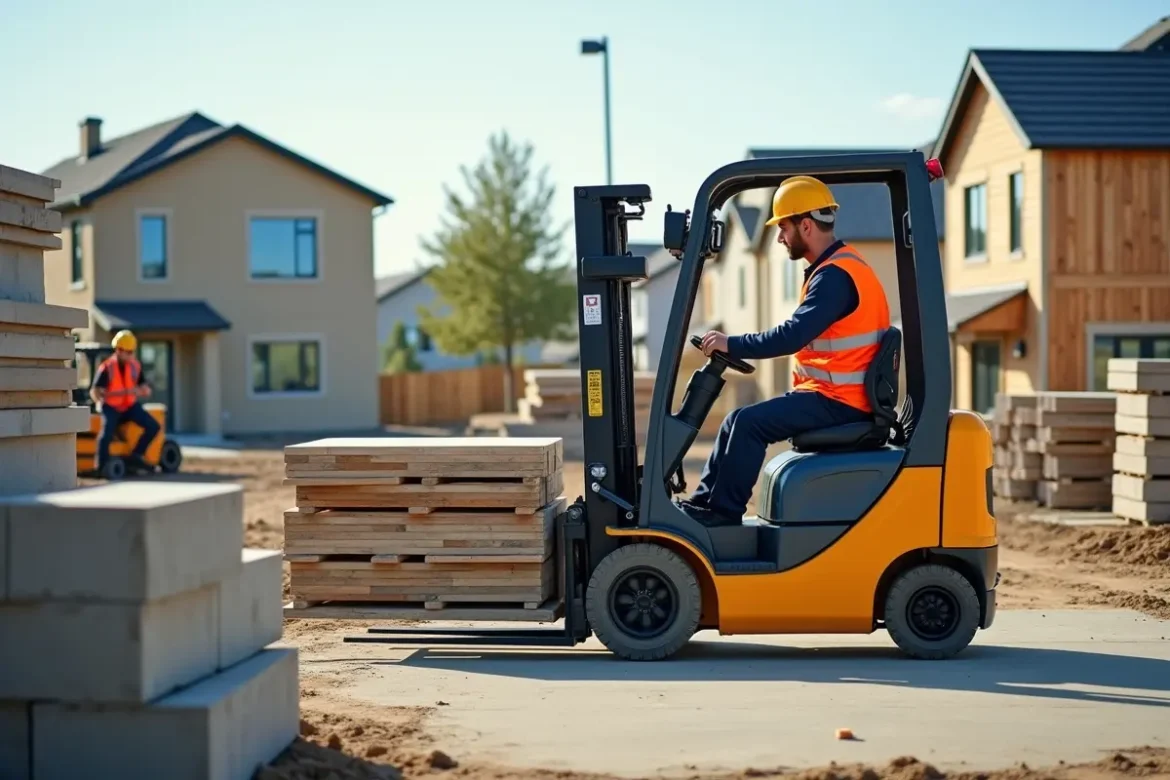
Ready to trim THOUSANDS from your build budget?
Material handling is something most home builders neglect. And yet, how you plan and manage it can make or break your construction profitability.
The problem is that most builders obsess over material costs. But don’t consider the additional expenses of moving those materials around the building site. And this oversight can easily result in 15-20% in unnecessary project expenses!
The good news is with some foresight, planning, and judicious equipment choices, you can dramatically slash your handling costs while also improving safety and productivity.
This article reveals:
- 1 – The Cost of Material Handling
- 2 – Equipment Selection Tips
- 3 – Site Organisation Strategies
- 4 – Safety and Cost Savings
- 5 – Buying vs Renting
- 6 – Wrap up
Contents
1 – The Cost of Material Handling
Material handling isn’t just shuffling boxes around your building site. It’s an essential activity with direct costs and profitability implications when building a house.
Material handling costs come in two forms:
- Direct expenses (renting equipment, labor, fuel, maintenance)
- Hidden opportunity costs (lost time, wasted materials, delays)
Did you know?
A recent industry study showed material handling alone can consume up to 25% of construction labor costs.
That means for every $300,000 you budget to build a home, you could be spending as much as $75,000 in material handling costs! And this number could be even higher in poor project planning scenarios.
But here’s the good news.
Most of those costs are entirely avoidable with the right approach.
Effective material handling is far more than just having some hardy laborers. It’s also about smart planning, using equipment to minimise unnecessary movements, avoid damage, and optimise efficiency. When you explore handling equipment options for a home build, you can dramatically reduce these hidden costs while also improving safety and productivity.
2 – Equipment Selection Tips
Selecting the right equipment forms the basis of material handling cost-effectiveness. But with so many options on the market, how do you know what’s right for your build?
First off, you need to evaluate the specific material handling needs of your project:
- The heaviest loads you’ll be moving?
- The distance materials need to be moved on site?
- What are the space limitations of your building site?
- Are you able to plug-in equipment to mains power or not?
Asking yourself these questions will help narrow down the equipment choices most appropriate for your project needs.
Versatile equipment with a high degree of functionality tend to give the best value for residential projects. Machines like telescopic handlers, mini-loaders, and adjustable forklifts are able to handle a range of tasks and adapt to different stages of a construction build.
Remember:
Equipment with the lowest price tag isn’t necessarily the most cost-effective solution. Spending more on quality handling equipment that better matches your specific project needs is almost always a better long-term investment.
3 – Site Organisation Strategies
What’s the best thing about good material handling? It’s not just about getting the right equipment. Smart site organisation and planning play an equally important role.
Proper organisation techniques can reduce material handling time by up to 40% on a building site.
Let’s look at some of the key strategies the pros use for efficient material handling when building a house:
Zone your construction site. Dedicate specific areas of your site for different materials and processes. This will dramatically reduce unnecessary handling and movement.
Just-in-time delivery. Whenever possible, schedule material deliveries to arrive just-in-time for installation. This eliminates on-site storage and handling costs.
Vertical transportation. Minimise the movement of materials up and down floors or levels.
Staging materials. Bring materials as close as possible to where they are installed or used on site.
A recent construction productivity survey revealed that workers spend nearly 30% of their time searching for and handling materials. By putting smart organisation techniques in place, you can reclaim this lost time and focus on value-adding construction work.
Optimising material flow and handling efficiency in this way can lead to significant savings in both labor and project time.
4 – Safety and Cost Savings
Construction is a dangerous industry. The safety benefits of proper material handling must never be understated.
Improper lifting and material handling is one of the biggest causes of construction injuries.
Injuries don’t just impact workers, they can also lead to project delays, additional insurance costs, and even legal liability.
The right equipment and processes can dramatically reduce these risks. Proper material handling equipment doesn’t just move materials faster when building a house. It also goes a long way in preventing serious accidents and injuries.
Some of the key safety benefits of good material handling are:
- Less manual lifting
- Preventing falls from carrying materials up/down stairs
- Avoiding repetitive motion injuries
- Trips from misplaced materials
Investing in proper handling equipment and training is actually an investment in the success of your project. The benefits come back to you in the form of lower insurance costs, higher worker productivity, and faster project timelines.
5 – Buying vs Renting
A secret that many builders overlook…
You don’t always need to purchase equipment outright. Renting handling equipment is the most financially viable option for many residential projects.
Whether you rent or buy will depend on your individual circumstances:
- Project length. How long will you need the equipment for?
- Frequency of use. Will you use it again on future projects?
- Storage availability. Do you have space to store owned equipment?
- Maintenance capabilities. Can you service and maintain equipment?
Renting is most cost-effective for smaller builders. The equipment is specialised, so you’ll only use it infrequently. Equipment rental is also more flexible with shorter terms and typically includes maintenance in the price.
Buying your own equipment makes more sense for those who do multiple projects in parallel or have ongoing needs.
Here’s a smart way to approach it:
Rent equipment for the first time you need it. This way you can try out different options and find the most effective tools for your work without a huge up-front investment.
Leveraging Technology For Tracking
Material handling also isn’t just a physical task. Tracking materials throughout the build process is critical to efficiency.
Simple inventory management systems can help avoid:
- Over-ordering materials
- Losing track of deliveries
- Running out of crucial components
- Theft or material loss
Builders are increasingly using QR codes, RFID tags, and mobile apps to keep track of materials from delivery to installation. These allow real-time visibility into your materials inventory and help optimise handling.
The best part is these systems are becoming affordable for even small builders.
6 – Wrap up
Material handling is a critical consideration for home builders. But it’s one most neglect at their own expense.
By implementing these strategies for efficient material handling when building a house, you can:
- Lower labor costs and boost efficiency
- Improve worker safety and prevent injuries
- Minimise material waste and damage
- Speed up build times and improve productivity
The right approach to material handling is a combination of good equipment choices, efficient site organisation, and safety planning. Buying vs Renting decisions should also be made carefully based on individual circumstances.
Building a house doesn’t have to be a logistical nightmare. Proper material handling is a key part of creating a project that comes in on budget and schedule, with a safe work environment for all involved.
Investing time in proper material handling strategies may seem like a pain at the start. But the time, money, and stress it saves you will make it some of the best preparation for your next building project.



